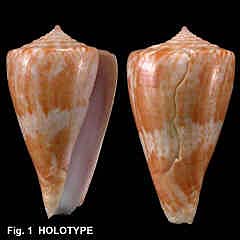|
|
|
|
Conus wallangra (Garrard, 1961) Description: Shell light in weight, sides slightly concave to slightly convex. Body whorl smooth, or sculptured with widely spaced spiral grooves, often restricted to lower half of body whorl, and obsolete in large shells; grooves microscopically punctate. Shoulder fairly sharply angled. Spire low to medium in height, concave to straight in outline; spire whorls concave or straight, each with 5-7 spiral threads. Aperture constant width, outer lip straight, columella with prominent plait at base. Colour variable and poorly defined; bands of white spots, sometimes forming into diagonal stripes, at base, midbody and shoulder, and usually with about seven dashed thick spiral brown lines on the top half of the body whorl. Size: Up to 50 mm in length, typically 30-40 mm. Distribution: Endemic to Australia; Caloundra, Queensland, to Stanwell Park (south of Sydney), NSW. Habitat: Known from 40-160 metres. Very uncommon. Comparison: C. sculletti is similar in shape to this species, but differs in having smooth spire whorls. Shorter specimens of C. wallangra with ribs on only the lower half of the body whorl could be confused with C. sydneyensis, but the colour pattern is quite different. Shells with spiral grooves on all of the body whorl could be confused with C. minnamurra, but the grooves are never as close or as strong as in that species. The plait at the base of the columella is a diagnostic feature, but a similar plait is found in C. angasi. (This is not visible in the figure, being deep within the aperture). Fig. 1 HOLOTYPE East of Stanwell Park, NSW (C.063323) |
